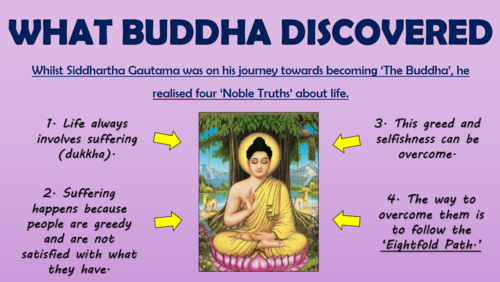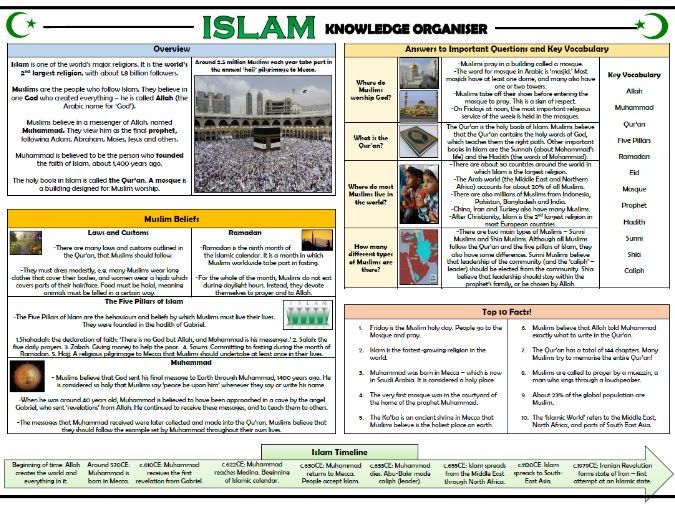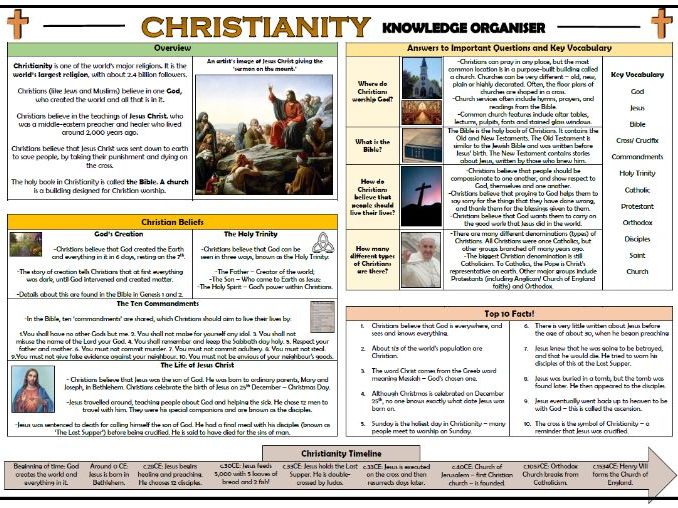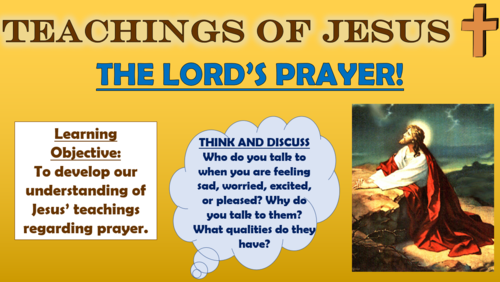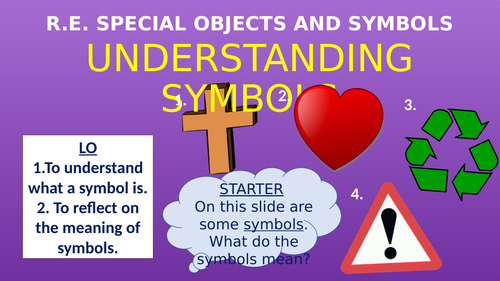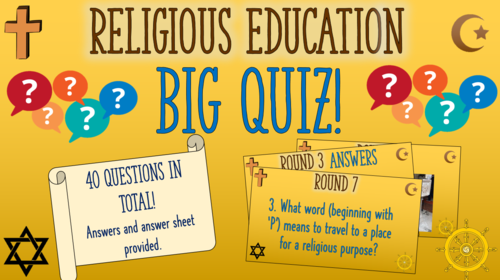
3k+Uploads
1880k+Views
2219k+Downloads
Religious education

KS1 RE - My Special Places!
In this engaging lesson, students consider the places that are important to them. The lesson serves as a foundation for children’s later learning about places that are special to people of different faiths.
The learning is guided by a clear and colourful PowerPoint presentation, which guides students through the following step-by-step journey:
-Discussing the differences between a house and a home;
-Considering what features make a home a special place to many people;
-Identifying the things that make their own homes a special place;
-Brainstorming other places that people may consider as special, e.g. their town or their school;
-Understanding that different people are individuals, and have their own opinions of places that are special;
-Completing a plenary activity to assess their understanding;
-Self-reflecting on the extent to which they feel they have met the learning objective.
This resource pack includes the comprehensive PowerPoint presentation (17 slides) and the template for the main special places activity (provided in Word and PDF). There is everything that you need here to teach the lesson.
In the past, I have used this lesson with children from across Key Stage 1 - the key learning is aligned with curriculum expectations for RE, and also the content prescribed by most diocese regions. All images are licensed for commercial use.

Judaism Knowledge Organiser!
This detailed and visually-appealing resource offers a complete reference point for students learning about/ revising their understanding of Judaism. It contains comprehensive sections under the following headings:
-Judaism Overview;
-Jewish Beliefs;
-Judaism Timeline;
-Key Vocabulary;
-Top Ten Facts;
-Answers to the Important Questions.
Key words and ideas are underlined for easy reference. The resource is designed to be printed onto A3, and is provided as both a PDF and a Word version (so that you can edit if you want to).

The Buddha - The Eightfold Path!
In this engaging lesson, students gain a deeper understanding of the Noble Eightfold Path - the eight practices governing the lives of Buddhists.
The learning is guided by a clear and colourful PowerPoint presentation, which guides students through the following step-by-step journey:
-Defining what the Eightfold Path is;
-Breaking down the different practices that make up the Eightfold Path;
-Establishing why Buddhists follow the Eightfold Path;
-Thinking about how they can apply the principles of the Eightfold Path to their own lives;
-Considering a deeper thinking extension question;
-Completing a plenary to assess their understanding.
This resource pack contains a comprehensive Powerpoint, alongside an eye-catching worksheet.
In the past, I have used this lesson with children from across Key Stage 2 - the key learning is aligned with curriculum expectations for RE, and also the content prescribed by most diocese regions. All images are licensed for commercial use.

Islam Knowledge Organiser!
This detailed and visually-appealing resource offers a complete reference point for students learning about/ revising their understanding of Islam. It contains comprehensive sections under the following headings:
-Islam Overview;
-Islamic Beliefs;
-Islam Timeline;
-Key Vocabulary;
-Top Ten Facts;
-Answers to the Important Questions.
Key words and ideas are underlined for easy reference. The resource is designed to be printed onto A3, and is provided as both a PDF and a Word version (so that you can edit if you want to).

Churches - The Features of Churches!
In this lesson, students learn about the key features of Anglican churches.
Some of the features covered include: the font, the altar, the pulpit, the lecturn, the nave, the crucifix and stained glass windows. Students learn about the key purpose of the features, and where they can be found in the church.
Students also begin to comprehend what the features symbolise.
This resource pack contains a comprehensive 16-slide Powerpoint, alongside an eye-catching worksheet. Two extension activities are provided in order to challenge higher ability learners.
In the past, I have used this lesson with children from across Key Stage 2 - the key learning is aligned with NC expectations for RE, and also the content prescribed by most diocese regions. All images are licensed for commercial use, and are cited on the final slide.

KS1 RE - Special Places - Mosques!
In this engaging lesson, students develop their understanding of churches and what happens in them. It was originally taught as a part of an RE unit on ‘Special Places.’
The learning is guided by a clear and colourful PowerPoint presentation, which guides students through the following step-by-step journey:
-Knowledge harvesting what children already know about mosques, and what they would like to find out;
-Learning the basics about Mosques, before reading and comprehending ‘An Important Job for Qaswa the Camel’ - an age-appropriate story about the first mosque;
-Studying a number of images of different features in mosques and discussing why each feature is important;
-Understanding what makes mosques special places to Muslims, and finding similarities and differences between mosques and churches;
-Completing a plenary activity to assess their understanding;
-Self-reflecting on the extent to which they feel they have met the learning objective.
This resource pack includes the comprehensive PowerPoint presentation (24 slides) and the story for the comprehension activity (provided in Word and PDF). There is everything that you need here to teach the lesson.
In the past, I have used this lesson with children from across Key Stage 1 - the key learning is aligned with curriculum expectations for RE, and also the content prescribed by most diocese regions. All images are licensed for commercial use.

RE - Sikhism - The Ten Gurus!
In this engaging lesson, students develop their understanding of Sikhism through learning about the ten human gurus.
The learning is guided by a clear and colourful PowerPoint presentation, which guides students through the following step-by-step journey:
-Recalling key information about the life and beliefs of Guru Nanak;
-Researching the nine subsequent Sikh Gurus, using a structured template;
-Sharing their findings with their classmates;
-Considering the key messages communicated by each of the Sikh gurus and justifying which they feel are the most important;
-Completing a creative task in which they make a Sikh Guru timeline;
-Self-reflecting on the extent to which they feel they have met the learning objectives.
This resource pack includes the comprehensive PowerPoint presentation (17 slides) and the research template. There is everything that you need here to teach the lesson.
In the past, I have used this lesson with children from across Key Stage 2 - (predominantly upper KS2) the key learning is aligned with curriculum expectations for RE, and also the content prescribed by most diocese regions.

Christianity Knowledge Organiser!
This detailed and visually-appealing resource offers a complete reference point for students learning about/ revising their understanding of Christianity. It contains comprehensive sections under the following headings:
-Christianity Overview;
-Christian Beliefs;
-Christianity Timeline;
-Key Vocabulary;
-Top Ten Facts;
-Answers to the Important Questions.
Key words and ideas are underlined for easy reference. The resource is designed to be printed onto A3, and is provided as both a PDF and a Word version (so that you can edit if you want to).

Hinduism Knowledge Organiser!
This detailed and visually-appealing resource offers a complete reference point for students learning about/ revising their understanding of Hinduism. It contains comprehensive sections under the following headings:
-Hinduism Overview;
-Hindu Beliefs;
-Hinduism Timeline;
-Key Vocabulary;
-Top Ten Facts;
-Answers to the Important Questions.
Key words and ideas are underlined for easy reference. The resource is designed to be printed onto A3, and is provided as both a PDF and a Word version (so that you can edit if you want to).

Teachings of Jesus - The Lord's Prayer!
In this engaging lesson, students develop their understanding of Christian prayer. The lesson places a particular emphasis upon the Lord’s Prayer.
The learning is guided by a clear and colourful PowerPoint presentation, which guides students through the following step-by-step journey:
-Considering who we confide in when we need to talk to someone, and understanding that Christians can confide in God;
-Knowledge recall - remembering key facts about Jesus’ life and teaching;
-Watching an engaging, age-appropriate video about how Christians pray and demonstrating understanding through answering questions;
-Using the worksheet provided to read and comprehend the Lord’s prayer, answering the key questions provided;
-Self-reflecting on how the teachings may influence their own lives;
-Considering the extent to which they feel they have met the learning objective.
The resource pack includes everything you need to teach the lesson, including the comprehensive PowerPoint presentation and the ‘Lord’s Prayer’ worksheet (provided in both Word and as a PDF). Just download and teach!
In the past, I have used this lesson with children from across Key Stage 2 with minor adaptations for age - the key learning is aligned with curriculum expectations for RE, and also the content prescribed by most diocese regions. All images are licensed for commercial use.

Salah - The Second Pillar of Islam!
In this engaging and comprehensive lesson, students are introduced to the second pillar of Islam - Salah.
Children learn through collating their collective prior knowledge, watching an interesting video (hyperlinked) and answering comprehension questions about the Salah. They then develop their understanding by learning about the daily prayer routine and the ‘wudu’ (washing ritual).
The lesson is tried and tested, and is easy for teachers and students to follow. It contains a comprehensive 17-slide Powerpoint which offers a step-by-step guide throughout the lesson, in addition to the worksheet template for the creative ‘routines’ activity (in both Word and PDF). Challenge activities are provided in order to enrich learning for higher-attaining learners.
In the past, I have used this lesson with children in upper Key Stage 2 (years 5 and 6). The key learning is aligned with regional expectations for RE, and also the content prescribed by most diocese regions. All images are licensed for commercial use, and are cited on the final slide.

Understanding Symbols - KS1 RE Lesson!
In this engaging and informative lesson, children learn what symbols are, and begin to interpret and reflect on the meaning of symbols. They apply this knowledge in creating their own symbols, considering what the objects/ animals, colours and shapes that they select represent.
I used this as an introductory lesson, before then going into more depth about different religious symbols in the subsequent lessons. Children enjoyed it and it gave them a solid understanding of symbols to build on in the next steps of their learning.
This resource pack contains a comprehensive and colourful 15-slide Powerpoint, which guides teachers and students through the learning activities. A template worksheet is also provided (in Word and PDF) for the students to create and describe their symbol.
In the past, I have used this lesson with children in both Years 1 and 2 - the key learning is aligned with national expectations for RE, and also the content prescribed by most diocese regions. All images are licensed for commercial use, and are cited on the final slide.

Religious Education Big Quiz! (KS2/KS3)
This wide-ranging and comprehensive RE quiz contains 40 questions. It was originally designed for high attaining year 5/6 classes as an end of term activity, but may also be suitable for lower KS3 groups.
Questions are split into 8 rounds of 5 questions each. To add variety and promote engagement, there are a range of regular, true or false, multiple choice and picture questions. Answers are given at the end of each round. The rounds included are:
1.) Churches
2.) Jesus Christ
3.) Islam
4.) Buddhism
5.) Judaism
6.) Hinduism
7.) Religion around the World
8.) Final Round Lucky Dip
A team answer sheet is included, provided in both Word and PDF.

KS1 RE - The Life of a Vicar!
In this engaging lesson, students develop their understanding of the roles of vicars. They consider their routines and actions, and how vicars live their daily lives. It is great as a standalone lesson, or as a part of a unit on ‘special ways of living.’
The learning is guided by a clear and colourful PowerPoint presentation, which guides students through the following step-by-step journey:
-Thinking about the definition of a vicar (and how this differs from the more general definition of a priest;
-Introducing children to the daily life of vicars, including discussing their many roles and responsibilities, through watching an interesting and age-appropriate video;
-Answering questions to check their understanding of the roles of vicars;
-Completing a storyboard (using a provided template) to show the daily routine of vicars;
-Learning about the different clothes worn by vicars, before drawing and labelling a vicar in uniform;
-Considering questions that they would ask to a vicar if they were given the opportunity (you could email these to your local vicar, or even better, invite them in for a Q and A session);
-Self-reflecting on the extent to which they feel they have met the learning objectives.
This resource pack includes the comprehensive PowerPoint presentation (15 slides) the template for the storyboard, and the hyperlink for the video explaining about the daily life of a vicar. There is everything that you need here to teach the lesson.
In the past, I have used this lesson with children from across Key Stage 1 - the key learning is aligned with curriculum expectations for RE, and also the content prescribed by most diocese regions. All images are licensed for commercial use.
Bundle Sale

Personal Development Assemblies Huge Bundle!
These fun and original assemblies have been designed aid children in developing their skills of:
Compassion
Honesty
Resilience
Humility
Celebrating differences
Thankfulness
Patience
Peace
Creativity
All of the assemblies are tried and tested, and each has been really well received in the past.
The slides are visually engaging and well-presented, and the subject matter is tailored to the interests and needs of young people. For example, there are references to scenarios and dilemmas that they themselves might find themselves in, in order to help them to make the right choices in their own lives.
There are also fun role-play activities, beautiful, thought-provoking videos exemplifying each theme, and various discussion activities regarding how to show the skills in different areas of their own lives. No further resources are required, everything that you need to present the assemblies is included.
Each set of slides are fairly self-explanatory, but I’ve included guidance notes for each assembly to assist the speaker. Hope that you find this useful!

Buddhism Knowledge Organiser!
This detailed and visually-appealing resource offers a complete reference point for students learning about/ revising their understanding of Buddhism. It contains comprehensive sections under the following headings:
-Buddhism Overview;
-Buddhist Beliefs;
-Buddhism Timeline;
-Key Vocabulary;
-Top Ten Facts;
-Answers to the Important Questions.
Key words and ideas are underlined for easy reference. The resource is designed to be printed onto A3, and is provided as both a PDF and a Word version (so that you can edit if you want to).
Bundle Sale

Major Religions Knowledge Organisers Bundle!
These clear, detailed and visually-appealing resources offer a complete reference point for students learning or revising knowledge relating to each of the world’s major religions, including:
Buddhism
Christianity
Islam
Judaism
Sikhism
Hinduism
Each organiser contains a number of comprehensive sections to guide learning and revision including:
Religion Overview;
Beliefs;
Timelines;
Important Vocabulary;
Answers to the Important Questions;
Top Ten Facts.
The resources are designed to be printed onto A3, and are provided as both PDF and Word versions (so that you can edit if you want to). All images used are licensed for commercial use and are cited on a separate document (included). The knowledge organisers may be used for students of all ages, but are most suitable for children in upper KS2 and lower KS3.

Mary, Mother of Jesus - Collective Worship Session!
This fun and original collective worship session aims to guide children towards building their knowledge of Mary, mother of Jesus, through:
-Gathering what they already know about Mary;
-Learning about the annunciation of Mary, through reading an engaging and thought-provoking script;
-Answering comprehension questions based on the ideas and events of the annunciation;
-Considering Mary’s response and actions after learning that she would be the mother of Jesus;
-Studying examples of Mary’s devotion and love towards Jesus, through engagement with religious artworks and Bible quotations;
-Discussing the Christian values that Mary demonstrated throughout her life;
-Singing a hymn about the Mother Mary (hyperlinked);
-Closing with a prayer related to the Mother Mary.
The session includes a 16-slide presentation, the script for the ‘anunciation’ section (in both Word and PDF) and the hyperlink to the hymn. No further resources are required, everything that you need to present the assembly is included.
This assembly was originally delivered to all of the children in a primary school (KS1 and KS2), although with suitable adaptations it could also be suitable for students in KS3.

RE - Special Ways of Living - Muslim Prayer!
In this engaging lesson, students are introduced to how Muslims pray. They consider the rituals that these people follow and the reasons behind their processes.
The learning is guided by a clear and colourful PowerPoint presentation, which guides students through the following step-by-step journey:
-Recalling their prior learning about how Christians and Buddhists live in special ways;
-Learning about the Muslim ritual of praying 5 times a day, and consider their own daily cycles;
-Learn other key facts about Muslim prayer, for example how they are called to prayer and the rituals that they follow - aided by the use of interesting videos (hyperlinked);
-Comparing and contrasting how Muslims pray compared with other religions;
-Self-reflecting on the extent to which they feel they have met the learning objectives.
This resource pack includes the comprehensive PowerPoint presentation (16 slides) , the resources for the routine activity (in Word and PDF) and the hyperlink for the videos. There is everything that you need here to teach the lesson.
In the past, I have used this lesson with children from across Key Stage 1 - the key learning is aligned with curriculum expectations for RE, and also the content prescribed by most diocese regions. All images are licensed for commercial use.

KS1 RE - The Guru Granth Sahib!
In this engaging and informative lesson, students gain a clear understanding of the Guru Granth Sahib. They learn about how the holy book is treated and used by Sikhs, and they also learn about how it relates to the teachings and songs of Guru Nanak.
The learning is guided by a clear and colourful PowerPoint presentation, which guides students through the following step-by-step journey:
-Reflecting on and recalling knowledge that they already built about special words and stories in their RE learning;
-Learn key facts about Guru Nanak;
-Read a story about Guru Nanak’s disappearance, his reappearance, and his special purpose, and answer comprehension questions;
-Learn about how the Guru Granth Sahib - including how it contains Guru Nanak’s songs, how it is housed by Sikhs, its role in baby-naming, and how Sikhs customarily show respect to the book;
-Consider their own personal spirituality, thoughts and ideas, in relation to the information that they have learnt;
-Compose their own songs about things that are special to them;
-Self-reflecting on the extent to which they feel they have met the learning objective.
This resource pack includes the comprehensive PowerPoint presentation (16 slides) and the story for reading (in both Word and PDF). There is everything that you need here to teach the lesson.
In the past, I have used this lesson with children from across Key Stage 1 - the key learning is aligned with curriculum expectations for RE, and also the content prescribed by most diocese regions. All images are licensed for commercial use.



